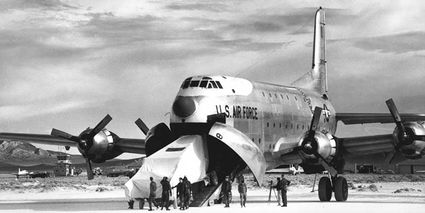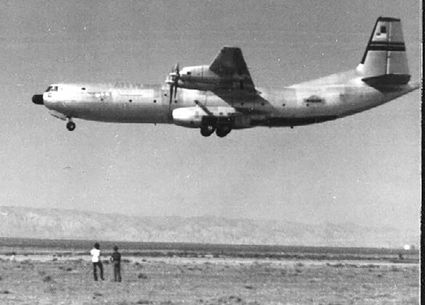Great USAF cargo planes of yesterday
Short Flights
The U.S. Air Force was formed in 1947 and there was a need for a larger cargo aircraft. At the time Douglas Aircraft Co. had produced the C-74 Globemaster, which was also ordered as a commercial airliner known as the DC-7.
The prototype YC-124 was basically the fifth variant of the C-74. It was designed with a new, deeper fuselage and strengthened landing gear. Powered by Pratt & Whitney R-4360-49 Wasp Major radial engines, it was flown for the first time on November 27, 1949. The type entered production as the C-124A, of which 204 were built, the first of them entering service with the USAF in May 1950 as the Globemaster II.
The air-cooled Pratt & Whitney R-4360 Wasp Major radial engine had 28 cylinders, four rows of seven. Each row was slightly offset or staggered to permit better cooling for the rows behind. It was nicknamed the "corncob" because that is what the staggered rows of cylinders resembled.
The fuselage of the Globemaster II had clamshell nose loading doors and a built-in loading ramp, an electric hoist like the C-74. There were two overhead cranes and each could travel the entire 77-foot length of the cargo hold. It was capable of handling such bulky cargo as tanks, field guns, bulldozers and trucks.
The flight deck, accommodated a crew of five and was mounted high in the nose, over the clamshell doors. When used in a transport role (with two decks installed), the Globemaster II could carry a maximum of 200 fully-equipped troops, or 123 stretcher cases plus 45 ambulatory patients and 15 medical attendants.
As you know, C-124's were also used to transport top-secret U-2 aircraft from Bakersfield and Burbank, CA to Groom Lake/Area 51 for classified flight test work.
The U.S. Air Force purchased 448 C-124s before production ended in 1955. Military personnel gave this aircraft the nickname 'Old Shakey.'
Serving with the USAF's Air Materiel Command, Far Eastern Air Force, Military Air Transport Service, Strategic Air Command and Tactical Air Command, and used in conjunction with Douglas C-133s.
In 1957, the USAF took delivery of the Douglas C-133 'Cargomaster,' the successor of the Douglas C-124 'Globemaster.' The C-133 carried twice the load of a C-124 and its main freight hold was 90-feet long. All types of military vehicles could drive up the ramp and between the main doors, which were situated at the rear of the fuselage, so there was no restriction in the cargo bay.
In 1972, Tehachapi resident Russ O'Quinn flew two C-133s to Mojave. He had his son and wife with him and my husband Al remembers watching the large cargo door slowly lower and O'Quinn's wife backed the family camper truck out of the aircraft and after removing a couple of wheels from the aircraft, the threesome hopped into the camper and drove off. The next day they were back with the second C-133!
The plan was to use the aircraft for Christian missionary purposes, but the plans fell through and the aircraft were sold to someone else. Sadly, they have sat here at Mojave in the boneyard for decades damaged by high winds. There was a time when these two huge airplanes sat on the flightline and everyone at the airport would joke about being able to tell if the winds were over 50 mph because the props would start turning! The C-133 was the USAF's only production turboprop-powered cargo or strategic airlifter, using four Pratt & Whitney T-34-P-9W turboprop engines.
The photo of Russ landing the C-133 at Mojave was provided by our late friend, Dan Sabovich, first General Manager of Mojave Airport. Dan passed away Feb. 17, 2005 – he was 80.
Dan relayed a great story about one of the Mojave C-133s and an unsuspecting security guard. One night around 1:30 a.m. the winds were howling out of the west, the props were turning on the C-133 and just as the security guard was driving by the aircraft, the small wind driven generator fell out of the main gear well; the generator is called a RAT for ram-air-turbine. The RAT is for emergency purposes when there is an electrical failure.
Apparently the master switch had been left on in the cockpit, and all the switches for the lights were on as well. Dan said that they used to have a lot of problems with people getting up into the aircraft and flipping all of the switches – well, everything was on!
The security guard was right in front of the airplane and all of the lights came on! Landing lights, the rotating beacon on top, all of the cockpit lights and the navigation lights. I cannot print what was said, but this poor guy was scared out of his wits! Amazing that the lights still worked after sitting for so long!
Strategic airlift planes are still needed by our military; Lockheed C-130s, C-141s, C-5s and C-17s are still in use today.
See you on our next flight!






